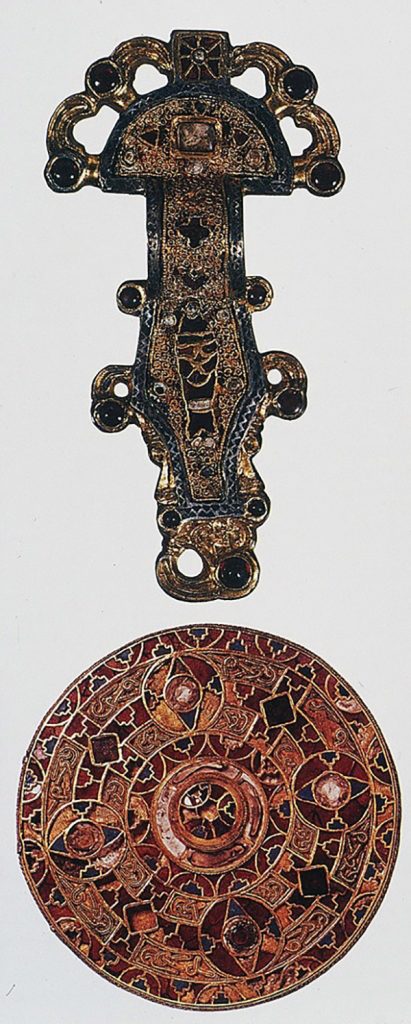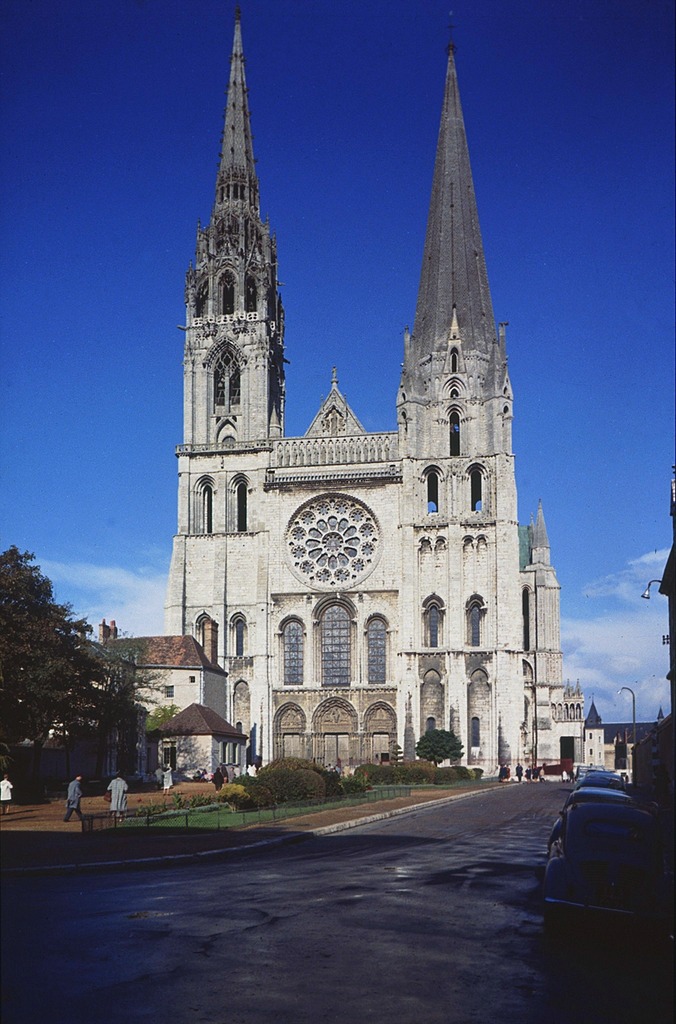Chapter 9.3: Barbarian Art and Gothic Style
The word “barbarian” did not originally carry the same connotations as it does today. It comes from the Greek word “barbaros,” meaning “foreign.” So, for our purposes, “barbarian” will be used here as a blanket term for non-Roman, nomadic, and illiterate groups traveling throughout Europe during the Middle Ages. The cultural exchange that occurred in Europe after antiquity can be seen through artwork, among other things; Romans borrowed from the “Barbarian” aesthetic, and vice versa.
Fibulae (singular: fibula) are brooches that were made popular by Roman military campaigns. They all consist of a body, a pin, and a catch. Ornate fibulae became all the rage in the early Middle Ages, and are one of the most commonly found objects in Barbarian grave sites.
Grave goods like fibulae provide the most concrete cultural information about barbarians due to the sparse amount of written documentation about them. The diverse ethnic groups were constantly borrowing from one another while putting their own spin on things.
Early styles derive from classical decorative and vegetal motifs, such as palmettos and scrolls, but these incorporate animal figures and human heads into their curvilinear structure. Depending on the region, these styles evolved in different ways, with the representational elements often becoming more cryptic and abstract and the continuous geometric designs more fluid, often underpinned by complex, compass-based patterns. The artists still worked primarily in metal, favoring gold, copper alloys, and iron, sometimes adding inlays of coral, amber, or enamel. Personal jewelry for both men and women, arms, armor, and horse trappings were elaborately decorated, as were everyday articles such as mirrors and vessel fittings.
This pair (see image at right) of Frankish fibulae is a great example of cloisonné, a technique that was popular in barbarian art. This technique is characterized by inlaid semi-precious stones. In fact, the word cloisonné literally means “partitioned” in French. The artisan would solder wires onto a metal base and fill the areas those wires created with stones (to be distinguished with cloisonné enamel, which has colored enamel baked within these partitions). This example also shows a popular motif in barbarian art of the Middle Ages: eagles! The eagle, originally a pagan symbol of the sun, was used by Imperial Rome and would later become an emblem of St. John. The ends of these fibulae are in the shape of Eagle heads, and little fish are shown on the main body of the brooches. Garnets were used to decorate the eyes of the eagles, and a wide range of gems were used to decorate the rest of the fibulae. These stunning pieces demonstrate the proficiency of barbarian metal workers during the Middle Ages.

Gothic Architecture
“Then arose new architects who, after the manner of their barbarous nations, erected buildings in that style which we call Gothic (dei Gotthi).” Florentine historiographer Giorgio Vasari (1511–1574) was the first to label the architecture of preceding centuries “Gothic,” in reference to the Nordic tribes that overran the Roman Empire in the sixth century. The label is now used to characterize an art form based on the pointed arch, which emerged around Paris in the middle of the twelfth century, was practiced throughout Europe, and lingered in some regions well into the sixteenth century.
Gothic architecture is the result of an engineering challenge: how to span in stone ever-wider surfaces from ever-greater heights? From 1100 onward, architects experimented with innovations that, once properly combined, allowed the dissolution of the wall and a fluid arrangement of space. For example, they adopted the pointed arch, which has a lesser lateral thrust than the round arch and is easily adaptable to openings of various widths and heights. They also developed a system of stone ribs to distribute the weight of the vault onto columns and piers all the way to the ground; the vault could now be made of lighter, thinner stone, and the walls opened to accommodate ever-larger windows. Equally important, flying buttresses began to appear in the 1170s, whose vertical members (uprights) are connected to the exterior wall of the building with bridge-like arches (flyers). These external structures absorb the outward thrust of the vault at set intervals just under the roof, making it possible to reduce the building’s exterior masonry shell to a mere skeletal framework.

With growing assurance, architects in northern France, and soon all over Europe, competed in a race to conquer height. The vault of each new cathedral strained to surpass that of its predecessors by a few meters. The typical elevation of a Gothic cathedral interior, with story upon corresponding story, draws the gaze to the highest point in the vault in an irresistible upward pull symbolic of the Christian hope of leaving the terrestrial world for a heavenly realm. Such a transcendent experience of architecture is reinforced by the rich stained-glass windows, sometimes spanning the entire height of the edifice. Decorated with scenes from the Bible, the lives of the saints, or with larger figures of prophets and other personages, stained-glass windows were central to the perception of the cathedral as a compendium of the Christian faith. Throughout the thirteenth century, an obligatory feature in most cathedrals was the monumental rose window with God, Christ, or the Virgin at its center, surrounded by the cosmos. The shimmering, colored light called to mind the heavenly Jerusalem described in the Book of Revelations (the Apocalypse) as a city of gold and precious stones.
This was the formula we can see in all the great cathedrals built in the Late Middle Ages.
Video
Chartres Cathedral (18:55)
Media Attributions
- Figure 1. Frankish fibulae, Top: looped fibula, 4 in., silver gilt worked in filigree, with inlays of garnets and other stones. (Musee des Antiques Nationales, Spain; Image source: University of California, San Diego via Artstor. Used with permission, for education use only)
- Figure 2. Chartres: Cathedral West facade, rebuilt 1194-1260 (France; Image source: University of California, San Diego via Artstor. Used with permission, for education use only)
Candela Citations
- Fibulae. Authored by: Rebecca Mir. Provided by: Smarthistory. Retrieved from: https://smarthistory.org/fibulae/. License: CC BY-NC-SA: Attribution-NonCommercial-ShareAlike
- Gothic Art. Provided by: The Met. Retrieved from: https://www.metmuseum.org/essays/gothic-art. License: All Rights Reserved. License Terms: Used with permission, for educational use only

